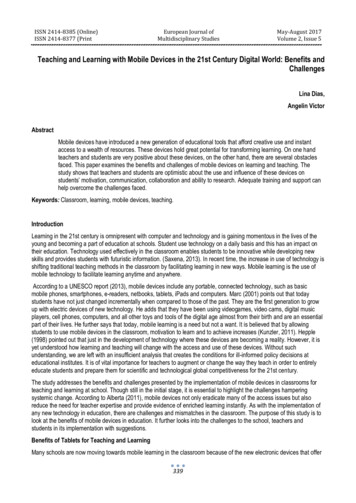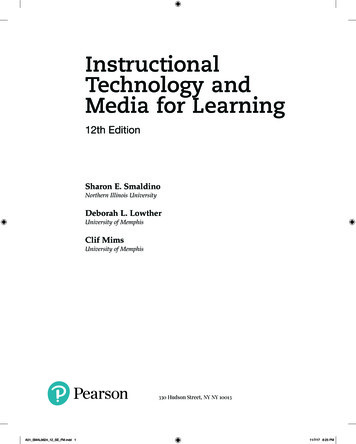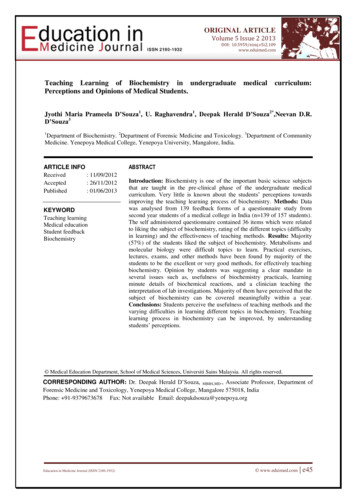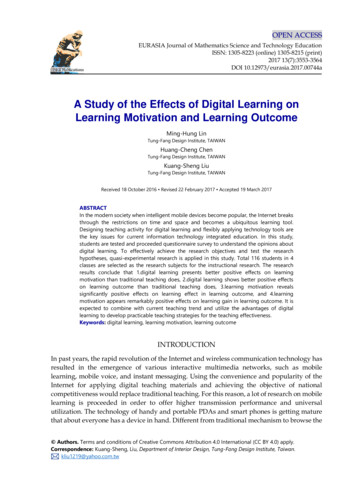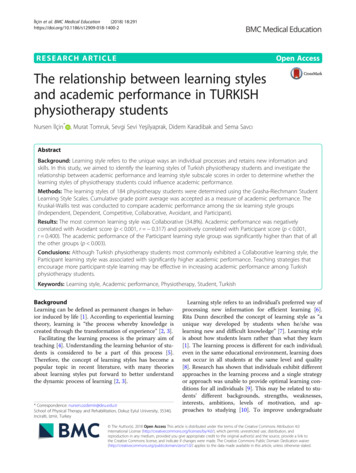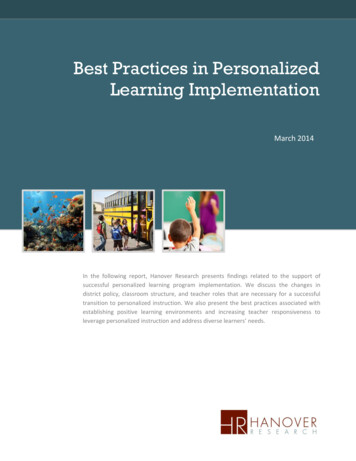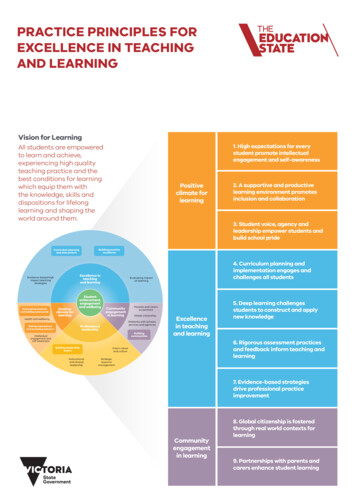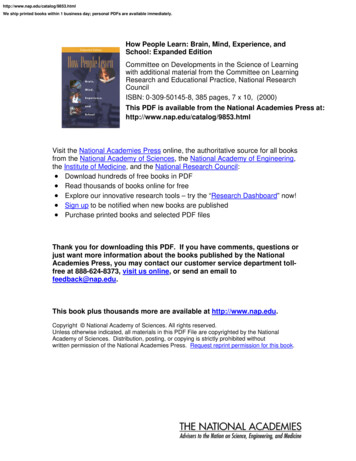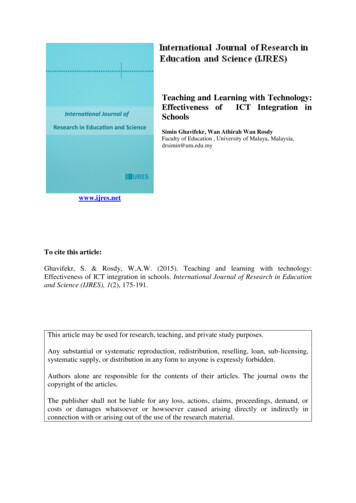
Transcription
Teaching and Learning with Technology:Effectiveness ofICT Integration inSchoolsSimin Ghavifekr, Wan Athirah Wan RosdyFaculty of Education , University of Malaya, Malaysia,drsimin@um.edu.mywww.ijres.netTo cite this article:Ghavifekr, S. & Rosdy, W.A.W. (2015). Teaching and learning with technology:Effectiveness of ICT integration in schools. International Journal of Research in Educationand Science (IJRES), 1(2), 175-191.This article may be used for research, teaching, and private study purposes.Any substantial or systematic reproduction, redistribution, reselling, loan, sub-licensing,systematic supply, or distribution in any form to anyone is expressly forbidden.Authors alone are responsible for the contents of their articles. The journal owns thecopyright of the articles.The publisher shall not be liable for any loss, actions, claims, proceedings, demand, orcosts or damages whatsoever or howsoever caused arising directly or indirectly inconnection with or arising out of the use of the research material.
International Journal of Research in Education and Scienc eVolume 1, Issue 2, Summer 2015ISSN: 2148-9955Teaching and Learning with Technology: Effectiveness of ICT Integrationin SchoolsSimin Ghavifekr*, Wan Athirah Wan RosdyFaculty of Education, University of Malaya, MalaysiaAbstractIntegration of Information, Communication, and Technology (ICT) will assist teachers to the global requirementto replace traditional teaching methods with a technology-based teaching and learning tools and facilities. InMalaysia, ICT is considered as one of the main elements in transforming the country to the future development.The Ministry of Education, through the latest Education Blue print (2013-2025), insights the importance oftechnology-based teaching and learning into the schools’ national curriculum. This study aims to analyzeteachers’ perceptions on effectiveness of ICT integration to support teaching and learning process in classroom.A survey questionnaire was distributed randomly to the total of 101 teachers from 10 public secondary schoolsin Kuala Lumpur, Malaysia. The data for this quantitative research were analyzed for both descriptive andinferential statistic using SPSS (version 21) software. The results indicate that ICT integration has a greateffectiveness for both teachers and the students. Findings indicate that teachers’ well-equipped preparation withICT tools and facilities is one the main factors in success of technology-based teaching and learning. . It wasalso found that professional development training programs for teachers also played a key role in enhancingstudents’ quality learning. For the future studies, there is a need for consideration of other aspects of ICTintegration especially from management point of view in regard to strategic planning and policy making.Key words: ICT integration; Teaching and learning; Technology effectiveness; Education; MalaysiaIntroductionIn this 21st century, the term “technology” is an important issue in many fields including education. This isbecause technology has become the knowledge transfer highway in most countries. Technology integrationnowadays has gone through innovations and transformed our societies that has totally changed the way peoplethink, work and live (Grabe, 2007). As part of this, schools and other educational institutions which aresupposed to prepare students to live in “a knowledge society” need to consider ICT integration in theircurriculum (Ghavifekr, Afshari & Amla Salleh, 2012).Integration of Information, Communication, and Technology (ICT) in education refers to the use of computerbased communication that incorporates into daily classroom instructional process. In conjunction with preparingstudents for the current digital era, teachers are seen as the key players in using ICT in their daily classrooms.This is due to the capability of ICT in providing dynamic and proactive teaching-learning environment (Arnseth& Hatlevik, 2012). While, the aim of ICT integration is to improve and increase the quality, accessibility andcost-efficiency of the delivery of instruction to students, it also refers to benefits from networking the learningcommunities to face the challenges of current globalization (Albirini, 2006, p.6). Process of adoption of ICT isnot a single step, but it is ongoing and continuous steps that fully support teaching and learning and informationresources (Young, 2003).ICT integration in education generally means technology-based teaching and learning process that closelyrelates to the utilization of learning technologies in schools. Due to the fact that students are familiar withtechnology and they will learn better within technology-based environment, the issue of ICT integration inschools, specifically in the classroom is vital. This is because, the use of technology in education contributes alot in the pedagogical aspects in which the application of ICT will lead to effective learning with the help andsupports from ICT elements and components (Jamieson-Procter et al., 2013). It is right to say that almost allranges of subjects’ starts from mathematics, science, languages, arts and humanistic and other major fields canbe learned more effectively through technology-based tools and equipment. In addition, ICT provides the helpand complementary supports for both teachers and students where it involves effective learning with the help ofthe computers to serve the purpose of learning aids (Jorge et al., 2003). Computers and technology does not acts*Corresponding Author: Simin Ghavifekr, drsimin@um.edu.my
176 Ghavifekr & Athirahas a replacing tools for quality teachers but instead they are considered as an add-on supplements needed for thebetter teaching and learning. The need for ICT integration in education is crucial, because with the help oftechnology, teaching and learning is not only happening in the school environment, but also can happen even ifteachers and students are physically in distance. However, ICT integration is not a one-step learning process, butit is a continual process of learning that provides proactive teaching-learning environment (Young, 2003).ICT can be used in various ways where it helps both teachers and students to learn about their respective subjectareas. A technology- based teaching and learning offers various interesting ways which includes educationalvideos, stimulation, storage of data, the usage of databases, mind-mapping, guided discovery, brainstorming,music, World Wide Web (www) that will make the learning process more fulfilling and meaningful (Finger &Trinidad, 2002). On the other hand, students will benefit from ICT integration where they are not bounded to thelimited curriculum and resources, instead hands-on activities in a technology-based course is designed to helpthem to stimulate their understanding about the subject. It also helps teachers to design their lesson plans in aneffective, creative and interesting approach that would result in students’ active learning. Previous researchesproved that use of ICT in teaching will enhance the learning process and maximizes the students’ abilities inactive learning (Finger & Trinidad, 2002; Jorge et al., 2003; Young, 2003; Jamieson-Procter et al., 2013).Hermans, Tondeur, Van-Braak, and Valcke (2008) have identified three main stages for ICT to be highly valuedand regarded by the teachers; integration, enhancement and complementary. Integration approach is aboutimplementing right use of ICT in particular subject area that involved complex concepts and skills to improvestudent’s achievement and attainment. Besides, the review of curriculum is also needed so that only related ICTresources and appropriate software will be installed for the main aims and objectives of curriculum to beachieved. Enhancement approach is about using ICT to give great emphasis on the topic introduced. Forinstance, Microsoft PowerPoint can be used to present the topic in a very innovative and creative way that willlead into discussion and exchanging ideas and thoughts. Finally, complementary approach is when the ICT isused to aid and support the student’s learning. This approach allow students to be more organized and efficientin which they can take obtain the notes from computer, submit their works by email from home as long as theymeet the deadline and looking for information from various sources provided online to fulfil the task given tothem (Hermans et al., 2008) .Technology-based teaching and learning can make many changes in school that requires for proper planning andpolicy making. Researchers and policymakers must both have the same insight about the future plan. Dudeney(2010) noted that national ICT policies can serve several crucial functions. They provide a rationale, a set ofgoals, and a vision of how education systems run if ICT is integrated into teaching and learning process, andthey are beneficial to students, teachers, parents and the general population of a given country. Ministry ofEducation Malaysia has formulated three main policies for ICT in education. The first policy insists on allstudents are given opportunity to use ICT. This is aimed to reduce the digital gap amongst the schools. Thesecond policy focuses on the role and function played by ICT in education. Besides that, another policy stressedon the use of ICT for accessing information, communication and as productivity tool (Chan, 2002).However, infrastructure and facility of ICT is then needed to supply to the schools throughout the nation. A keyfactor in use of ICT is sufficient computer labs and ICT equipment. This is to ensure that subject teachers areeasily access to ICT tools whenever needed (Hennessy, Ruthven, & Brindley, 2005). Lack of adequate ICTequipment and internet access is one of the key problems that schools specifically in rural areas are facing now.For example, results of a research show that in Kenya, some schools have computer but this could be limited toone computer in the office only. Even in schools with computers, the student-computer ration is high. Inaddition, the report continues revealed that the schools with ICT infrastructure are supported by parents’initiative or community power (Chapelle, 2011).In most schools, technical difficulties sought to become a major problem and a source of frustration for studentsand teachers and cause interruptions in teaching and learning process. If there is lack of technical assistance andno repair on it, teachers are not able to use the computer for temporarily (Jamieson-Proctor et al., 2013). Theeffect is that teachers will be discouraged from using computers because of fear of equipment failure since theyare not given any assistance on the issue. Türel and Johnson’s study (2012) revealed that technical problemsbecome a major barrier for teachers. These problems include low connectivity, virus attack and printer notfunctioning. However, there are a few exceptions. Schools in the countries like Netherland, United Kingdomand Malta have recognized the importance of technical support to assist teachers to use ICT in the classroom(Yang & Wang, 2012).
International Journal of Research in Education and Science (IJRES)177In addition, teachers’ readiness and skills in using ICT are playing essential role in the use of ICT in education.Teachers need sufficient ICT skills to implement the technology and to have high confident level to use it in aclassroom setting. Besides, teachers require insight into the pedagogical role of ICT, in order to use itmeaningfully in their instructional process (Hennessy et al., 2005). According to Winzenried, Dalgarno andTinkler (2010) teachers who have gone through ICT course are more effective in teaching by using technologytools as opposed to those that have no experience in such training. A school in Ireland reported that teacherswho did not develop sufficient confidence avoided using ICT. Similar case happened in Canada, some teachersadmitted they were reluctant ICT users because they worried they might get embarrassed that the students knewmore about the technology than they did (Hennessy et al., 2005).Beyond basic skill training, schools had used a variety of strategies to provide further professional developmentfor teachers. According to Warwick and Kershner (2008) the significance and advantages of ICT should beknown by teachers in order to conduct a meaningful lesson with the use of ICT. Indeed, teachers should be sentto attend training courses to learn about integration ICT in teaching and learning process. Nonetheless, manyschool schools used peer-tutoring systems. A more skillful teacher in ICT would assist and guide anotherteacher who has less experience with ICT along the preparation work for teaching and learning process. As whathas been discussed, there are many factors to enable the use of ICT in classroom teaching and learning. Beginwith policy, follows by the supplement of all the ICT hardware and software facilities, continued by readinessand skills of teacher to integrate it into pedagogical process (Agbatogun, 2012). Besides, technical support andcontinuous professional development in ICT should be conducted from time to time. In short, all parties mustcooperate in order to bring the nation to become a country advance in technology.The main purpose of this study is to analysis the effectiveness of ICT integration in. Specifically, this study aimsto identify; (I) the effectiveness of ICT integration form teaching and learning perspectives and (II) the effectiveelements of ICT integration in teaching in public schools in Kuala Lumpur.Teachers’ Belief on Technology-based Teaching and LearningWith the development of learning technologies in the late 20th century, education system has changed rapidly.This is due to the capability of technology to provide a proactive, easy access and comprehensive teaching andlearning environment. Nowadays, Ministry of education in all over the world has provide a lot of facilities andtraining in order to enhance the use of advanced technologies in the countries’ teaching and learning process.A high budget has been placed in order to provide the equipment needed by teachers to improve the educationsystem. Despite all the efforts, most of the countries are facing similar problem whereby the teachers are notmaximizing the usage of the technology provided (Albirini, 2006). This has become a serious matter as manyprevious researches have proven the usage of ICT in teaching and learning process could improve students’achievement (Nakayima, 2011, Jamieson-Proctor et al., 2013). Many, researchers have taken an effort toanalyse the factors that affecting teachers’ acceptance of ICT usage in the classrooms (Capan, 2012; Virkus,2008; Zhang, 2013; Dudeney, 2010). It shows that, the major barrier of the implementation was the teachers’belief as the teachers are the person who implements the change in their teaching and learning process.Moreover, previous research (Cassim & Obono, 2011) shows that the correlation of teachers’ belief and the useof ICT are high. Teachers’ role is getting more important especially in usage of ICT in pedagogy which couldincrease the achievement of the students, their creativity and thinking skills.Furthermore, a research by Chien, Wu and Hsu (2014) has shown that students in school are having highexpectation on ICT integration in classroom as the new generation are born and grown with technologies andcould be define as the digital – native phenomenon. The younger the students, the higher their expectation areon ICT integration in classroom. It also proved that the integration of ICT is mostly dependent on the personalfactors which define as self-perceptions. This research also shows that the acceptance of ICT of teachers andstudents in classroom and outside of classroom whereby both are more likely to use technologies outside theclassroom. They found that the barriers of ICT integration in classroom are confidence, competence andattitudes of teachers reduce the percentage of ICT integration.Results of a previous research (Cox & Marshall, 2007) shows that teachers only need a traditional – centeredapproach when developing ICT skills in the classroom. The teachers are having high confidence andcompetency in using ICT in classroom even though it does not represents the types of ICT used. This is becausethey believe that ICT is a tool could help in learning process especially to relate with real life practices. Thisfactor has reform the teaching method to integrate ICT in order to create and construct knowledge for thestudents. The research shows that the relationship between competency and confidence could reflect the
178 Ghavifekr & Athirahbalances between training and pedagogically focused approaches in ICT professional development. With this,the school management could make sure that there are sufficient supports for the teachers to integrate ICT in theclassroom.However, teachers’ efficacy in urban schools changes as the years of experience of working and age of teachers(Cuban, 2001). It shows that the teachers’ efficacy are decreasing as the years of experience and age increasesbut somehow the decrease and the efficacy belief depend on the school management. School management heremeans the opportunities for collegial interaction, and the use of the instructional resources. Schools that couldprovide opportunities for teachers to reflect on teaching and learning with their colleagues and for administratorsand teachers to collaborate and communicate, as well as support the use of instructional resources. From thisresearch, the teachers efficacy belief is depend on the school management and culture. Therefore, if the schoolhas always implant the culture to change and teachers are always sent for training for upgrading themselves, andthen the integration of ICT in classroom will be easier to be enhanced in the classroom.Integration of ICT in the Malaysian ContextThe integration of ICT in classroom is getting more important as it help student in enhancing their collaborativelearning skills as well as developing transversal skills that stimulates social skills, problem solving, selfreliance, responsibility and the capacity for reflection and initiative. All these elements are core values thatstudents need to achieve in an active teaching and learning environment (Ghavifekr et al., 2014). Similarly, inMalaysia the government has implemented the integration of ICT in learning and teaching process in early1970’s. This is due to the importance of technology literate which produce critical thinking workforce to faceand involve the country in the global economy (Hamidi, Meshkat, Rezaee, & Jafari, 2011). Accordingly, manyschools were upgraded with computer’s lab, the internet connection, smart white boards, LCD and other ICTtools and equipment. Despite all these, the problem faced was the teachers’ skill and aptitude, technical supportand stability of the system in order to implement the policy successfully. However, the government is stillimproving and upgrading the systems to be fully utilising by ICT. As a developing country, exploration of thefactors that affecting Malaysian teachers’ ICT usage in schools can help to increase the integration of ICT incountry’s teaching and learning process.The Ministry of Education launched a comprehensive review of the education system in Malaysia in October2011. In order to raise the education standards, government developed a new national education blueprint; thelatest one is the Education Blueprint 2013-2025. This blueprint provides the plan for the sustainable educationaltransformation of the Malaysia education system until 2025 (Ministry of Education, 2012). This document alsoincludes the plan to raise the role of ICT in the whole education system. In order to complete the transformationmission, Blueprint proposed 11 strategic and operational shifts. ICT has been mentioned on the 7th shift , whichrequires scaling up quality learning in Malaysia by providing internet access and virtual learning environmentvia 1BestariNet for all schools in Malaysia by 2013 (Ministry of Education, 2012). It ensures possibilities ofmaximizing the implementation of ICT for self-guided learning.In line with global attempts on the deeper needs of educational performance, incompetence of teachers andinadequateness of hardware and software was also recognized by the Malaysian education authority (Educationand Manpower Bureau, 2008). It indicates that the ICT culture in schools should be improved with using ICTamong teachers in terms of training (Hussain, Morgan, & Al-Jumeily, 2011).The main goal of ICTimplementation in education proclaimed the vision and missions of the government to promote ICT in educationfor the following intentions:1) To surround schools with dynamic and innovative learning environments for students to become moremotivated and creative;2) To enable students to gain wider range of knowledge and be able to access to internet for developing a globaloutlook;3) To nurture students with capabilities of processing information more effectively and efficiently; and4) To develop students with attitudes and capability of life-long learningThe new era of ICT in education should be developed rapidly to appropriate extent in order to matching thecapability of students as well as teachers in educational experience due to the development of new informationtechnology. Results of a study by Abd Rahim and Shamsiah (2008) suggest that trainee teachers in Malaysiahave confidence to integrate ICT in their teaching practices. And the male teachers are more confident thanfemale teachers in using ICT integration in teaching. Moreover it shows that vocational teachers are more
International Journal of Research in Education and Science (IJRES)179confident to integrate ICT in teaching, because they can handle technical subjects and their experience enablethem to integrate ICT effectively in teaching (Abd Rahim & Shamsiah, 2008; Yunus, 2007). Furthermore, onlyminority of teachers in Malaysia professionally know the basic of ICT. The majority of them just had averageknowledge in ICT, and even a group of the teachers are poor in the related knowledge of ICT in Malaysia(Rosnaini & Mohd Arif, 2010). It indicates that level of ICT knowledge among teachers is one of the key factorsfor Malaysia society to make successful adoption of ICT in its education.The Conceptual FrameworkFor the purpose of this study in light of ICT integration to enhance a quality teaching and learning experience inschools , two theories of Diffusion of Innovations by Rogers (2003) and Technology Acceptance Model (TAM)by Davis (2003), has been identified and adapted to the research setting as the conceptual framework for thisresearch (Figure 1). Rogers’s theory stated as the process by which an innovation is communicated throughcertain channels and over time among the members of a social system. The process will starts with “knowledge”of the first channel that represents characteristics of the decision making unit by the ICT users in order tointegrate the technology. And it ends with “confirmation” by the users to accept the technology and integrate itaccordingly. The TAM theory comprises of various parts which is representing the process of ICT acceptanceby the users including; behavioral intension, perceived usefulness and perceived ease of use. While, perceivedusefulness refers to the degree to which person believes on the benefit from the use of a particular technology byimproving the job performance, perceived ease of use refers to the importance of a technology in being userfriendly for the users. Generally, TAM theory was developed to measure the effectiveness or success of atechnology in helping understanding the value and efficacy of a particular system. It is also considered as one ofthe most influential theories in contemporary information systems research. However, the theory has evolvedwith more specific variables explaining how a user can accept a technology over the years.PerceivedusefulnessuKNOWLEDGE ONTECHNOLOGY USEIntension to useCONFIRMATION& ACTUAL USEPerceived easeof useFigure 1. Conceptual framework of study (Davis, 2003; Rogers, 2003)The proposed framework includes various factors directly associated with the core aim of the study that explainshow knowledge and perceptions will affect the perceived usefulness and ease of use of ICT integration. Thefactors embedded in the conceptual framework have been meticulously interlaced, so that the interrelationshipamong them constitutes to measure their effectiveness on ICT integration by teachers. However, intension tointegrate ICT by teachers is the main variable that supports the key elements in the above framework such asease-of-use, functionality, flexibility, accessibility and integration. In addition, the intention of teachers to usethe technology is strongly influenced by their perceptions on usefulness of the system as well as perceived easeof use and determines their actual use of ICT. The proposed framework has guided this research in investigatingthe factors affecting the technology integration by school teachers.MethodResearch DesignIn this research, quantitative methodology was used to collect and analyze the data obtained from all therespondents. The researchers developed the questionnaire and finalized it before being distributed to the targetedgroup of respondents. Few sections on the questionnaire were designed specifically to address research
180 Ghavifekr & Athirahobjectives in regard with the effectiveness of ICT integration for students in learning and effective elements ofICT integration in public school in Kuala Lumpur. Therefore, the questionnaire was distributed to obtain thedata from the respondents.Population and SamplingThe overall total of respondents for this research was 101 teachers from public primary and secondary schools inKuala Lumpur. The questionnaire was randomly distributed to the respondents with teaching backgroundregardless of gender, race, teaching experience as well as highest teaching experience. There are no preferencesset by the researchers as long as the respondents come with teaching background especially in public primaryand secondary school in Kuala Lumpur. Since the targeted respondents for this research are meant forindividuals with teaching background, the researchers tried to get especially teachers from public primary andsecondary schools in Kuala Lumpur to be part of this research. Hence, the questionnaires distributed are notequal in numbers where teachers from secondary schools dominate the overall population as compared toteachers from primary schools.InstrumentA survey questionnaire with a total of 43 items was used as the main instrument in this study to analyze theeffectiveness of ICT integration in teaching and learning in public schools in Kuala Lumpur. A total of 101questionnaires were distributed where all respondents were asked to read the statements given and choose theiranswers based on 4-Likert scale ranged from 4 Strongly Disagree, 3 Disagree, 2 Agree and 1 StronglyAgree. The questionnaires consisted of 4 sections. Section A is about the demographic background of therespondents consists of 8 items that includes gender, race, teaching experience, type of school, school area,preference of teaching style, highest academic qualification and the ability of handling ICT in teaching. Theother 3 sections in the questionnaire focus more into teacher’s perception and the elements of effectiveness ofICT integration in schools. Section B comes with 15 items that looks into teacher’s perception of ICT inteaching, section C consists of 10 items that looks into the effectiveness of ICT integration for students inlearning meanwhile section D comes with 10 items that looks into the effective elements of ICT integration inteaching. The questionnaire used for this quantitative study was adopted and modified from the originalquestionnaire designed by Gulbahar and Guven (2008) that is considered suitable for this research. Some of theitems are designed and developed by the researchers accordingly with the title chosen so that the itemsdeveloped are able to provide the answers needed for both research questions.Data Collection ProcedureThe researchers modified the questionnaire before it is being finalized and distributed to the target group ofrespondents. Then, each researcher takes up 50 and 51 questionnaires respectively that made a total of 101questionnaires being distributed to all respondents. The data was collected within 2 weeks through randomdistribution and some of the questionnaires were sent to respondents email. The respondents were given 3-5days to complete the questionnaire and send it back to the researcher for data analysis. After 2 weeks, all thecomplete filled-up questionnaires were gathered and collected for further data analysis by the researcher to getthe output and findings for the research.Data Analysis ProcessAll the data collected from the respondents were gathered together to be analyzed using Statistical Package forthe Social Sciences (SPSS) version 21. The analysis includes both descriptive and inferential analysis. Theresearchers used descriptive analysis to analyze the frequency and percentage of the overall population in thedemographic background. Besides, it is also used to determine the mean, standard deviation, frequency andpercentage to identify the effectiveness of ICT integration for students in learning as well as the effectiveelements of ICT integration in teaching in public schools in Kuala Lumpur.
International Journal of Research in Education and Science (IJRES)181ResultsThe findings of this research will give the output needed by the researchers to answer the research questions.The findings are done according to the sections in the questionnaire and some inferential analysis that includesreliabili
Integration of Information, Communication, and Technology (ICT) will assist teachers to the global requirement to replace traditional teaching methods with a technology-based teaching and learning tools and facilities. In Malaysia, ICT is considered as one of the main elemen


